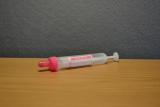|
This assay identifies the presence of the FIP1L1::PDGFRA fusion gene. However, it is not able to identify partners of PDGFRA other than FIP1L1. It is not suitable for assessment of fusion involving PDGFRB.
Assessment for the FIP1L1::PDGFRA fusion can also be performed by FISH by the South East Scotland Cytogenetics Service.
For assessment of other partners of PDGFRA and for fusion genes involving PDGFRB, please refer to South East Scotland Cytogenetics Service.
The FIP1L1::PDGFRA fusion oncogene arises as a result of an 800 kb deletion of chromosome 4q12. The presence of the FIP1L1::PDGFRA fusion is diagnostic of the WHO-defined category of “Myeloid/lymphoid neoplasm with PDGFRA rearrangement”. Such patients present with eosinophilia and, hence, the FIP1L1::PDGFRA fusion assay may be performed in patients with eosinophilia.
Due to the low level of expression of the fusion gene, the assay uses nested RT-PCR to assess for the presence of the fusion transcript.
Any positive result should be confirmed by FISH, where possible.
The assay is not suitable for detection of minimal residual disease.
For clinical advice on appropriate investigations and advice for the interpretation of test results, please see contact us.
|
